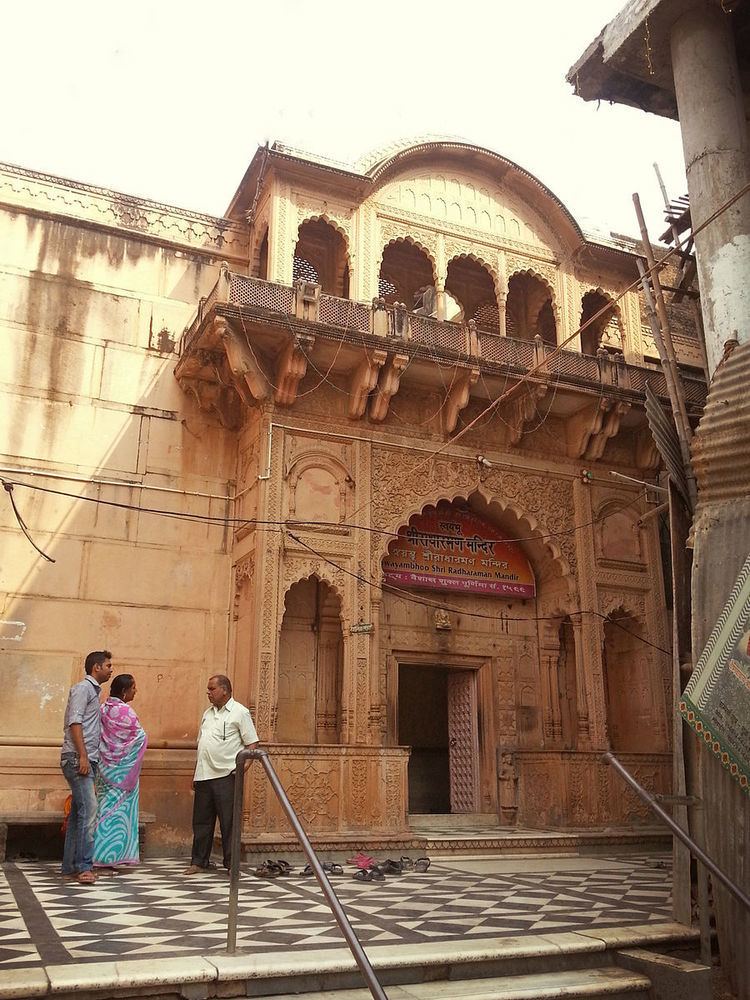Proper name Radha Raman Country India Elevation 169.77 m (557 ft) District Mathura Creator Gopala Bhatta Goswami | Devanagari श्री राधारमण मन्दिर State/province Uttar Pradesh Phone 094578 10041 Locale Vrindavan | |
 | ||
Other names Krishna, Shri Ji, Thakur Ji Address Panchayat Mandir, Shri Radharaman ji Maharaj,Vrindavan, Mathura, Uttar Pradesh 281121 Similar Radha Ramana, Banke Bihari Temple, Prem Mandir Vrindavan, Krishna Balaram Mandir, Seva Kunj | ||
Radha raman temple 27 02 2014
Sri Radha Raman Mandir or Sri Radha Raman Temple, is an early modern period Hindu temple in Vrindavan, India dedicated to Lord Krishna as Radha Ramana. It was constructed at the request of Gopala Bhatta Goswami at around 1542 AD.This temple is among the 7 temples of Thakur of Vrindavan including Sri Radhavallabh ji, Shri Bankey Bihari Ji, Shri Govind Dev ji and three others. The temple is exquisitely crafted and one of the most revered temples in Vrindavan, especially by the followers of Gaudiya Vaishnavism. It houses the original shaligram deity of Krishna alongside Radharani.
Contents
Sri radha raman temple
History
Radha Raman means the lover (ramana) of Srimati Radha. The temple was established over 500 years ago by Gopala Bhatta Goswami. At the age of thirty, Gopala Bhatta Gosvami came to Vrindavana. After Chaitanya Mahaprabhu's disappearance Gopala Bhatta Gosvami felt intense separation from the Lord. To relieve his devotee from the pangs of separation, the Lord instructed Gopala Bhatta in a dream "If you want my darshan then make a trip to Nepal".
In Nepal, Gopala Bhatta bathed in the famous Kali-Gandaki River. Upon dipping his waterpot in the river, he was surprised to see several Shaligrama shilas enter his pot. He dropped the shilas back into the river, but the shilas re-entered his pot when he refilled it.
Gopala Bhatta Gosvami found twelve Shaligrama shilas. It is believed that once a wealthy man came to Vrindavana and offered Gopala Bhatta a variety of clothes and ornaments for his Shaligramas in charity. However, Gopala Bhatta couldn't use these for his round-shaped Shaligramas. He advised the donor to give the deity decorations to someone else. It is believed that the donor refused to take them back and Gopala Bhatta kept the clothes and ornaments with his shilas.
On the Purnima (full moon) day, in the evening after offering naivedhya to his Shaligrama shilas, Gopala Bhatta put them to rest covering them with a wicker basket. Late in the night, Gopala Bhatta took a little rest. in the early morning he went to take bath in the Yamuna river. Returning from his bath, he uncovered the Shaligramas in order to render puja, and saw amongst them a Deity of Krishna playing the flute. There were now only eleven shilas and a Deity. The "Damodara shila" had manifested as the beautiful three-fold bending form of tri-bhangananda-krishna. In this way Radha Raman emerged in a perfectly shaped deity form from a sacred shaligrama shila. Devotees consider this image to be alive and that he grants a chosen family the privilege of assisting him in his daily schedule. In this way "the Lord has granted his wish and the stone was turned into the murti of Sri Krishna". As a narrative account of actualized Krishna-bhakti, Radharamana's appearance story highlights the divine-human relationship of love as the ontologically central category of ultimate reality.
The Prasad for Shri Radha Raman Ji is prepared by the male members of the Goswami families in the temple kitchen. The fire in the kitchen lit in early days of the temple still continues today. The Goswami families are allotted a calendar in advance for their personal seva (service) period and they perform seva accordingly. They also invite their disciples during their period and celebrate major family functions and ceremonies.
Inside the temple complex, the samadhi of Srila Gopal Bhatta Goswami is also situated. There the rarely available Unag vastra of Sri Chaitanya Mahaprabhu is kept.
